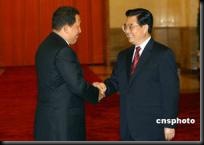
South American countries are opening up to China. (Source: Radio86)
South America was the US’s exclusive backyard during the Cold War. However, according to the Russian Strategic Communication expert Evgeny Pashentchev, because of the US’s alienating communication strategy, Latin America opened up for old enemies like Russia and China. But what is strategic communication and why is it so important?
Strategic communication is the projection of strategic values, interests and goals on the state level. STRATCOM has three main parts: public affairs, public diplomacy and information operations. Good examples of US STRATCOM are CNN or the American film industry. Through these channels, the US is able to spread knowledge about itself and its values worldwide.
Rising economies are not only interested in spreading knowledge about themselves globally, but also want to spread views on issues according to their interests. China is building a global communication network, Russia has an English information and news network, and the Arabic news agency Al-Jazeera provides alternative opinions for its audience. Strategic Communication is extremely important in the global development of economic networks according to state interests.
Mistakes in US communication

Evgeny Pashentchev (Source: Evgeny Pashentchev)
The last 20 years have brought a huge turnaround in world politics. The bipolar system disappeared as the Soviet Union, previously a major super power, collapsed. The world then became unipolar for a short period. However, the US does not have enough resources to continue as a leading power everywhere. In order to justify continuing to bolster security and defense capacities, it found new enemies in the Middle East. At the same time, a lack of resources caused Washington to give up its own backyard, the countries of Latin America.
“The United States of America, in my opinion, didn’t understand the principal political changes that appeared at the beginning of the 20th century,” said Professor Envegny N. Pashentchev, head of the Communication Management Centre at the Faculty of the Presidential Academy of National Economy and Public Administration in Moscow.
“Latin America stood behind the US during the Cold War. It supported US policy totally and had gained nothing by the 90s. Countries in South America have received no attention, only criticism about criminality etc. It was a bad communication strategy, because for a long period of time, this message came to Latin America: ‘We do not respect you.’ Of course, Latin Americans’ pride appeared to rise. They have very great traditions [of rebellion] coming from Bolivia and around there,” explains Professor Pashentchev.
New partnerships
In order to help each other as emerging economic powers, Russia, China and Brazil founded their own community. Because of this cooperation and weakened US influence, South America was able to create new partnerships. The main reason for this was the US's faulty communication, as they did not treat Latin American countries as equals.
China and Russia are very strongly present in South America, but their businesses are mainly collaborative, not competitive. Both provide services in the energy sector, but as China is mainly interested in the mining and energy sectors, Russia seeks cooperation in technology. “The rise of the technological level of all Russian businesses has led them to establish mutually beneficial ties with Latin American companies. For example, we are now producing buses with Brazil. As part of this cooperation, we also produce buses in Russia,” added Dr. Pashentchev. Russia's advantage is the international community’s memories of the Soviet Union. As a former military superpower, Russia sells weaponry to South American countries, like Venezuela, and is present in energy projects.
China's prospects
China is interested in political stability and doesn't intervene in domestic affairs
Unlike Russia, China seeks markets for products in the civil sphere mainly, plus raw material and energy sources. Although the type of relations it has can be compared to the US-Latin America model, China does not have a historical background as a superpower, and is therefore more accepted. As an equal partner, China is regarded as being very credible.
China launched its policy paper on Latin America in 2008. According to this document, China wants to promote mutual respect and achieve a win-win situation, even drafting a special paragraph devoted to media cooperation.
The case of Russia and China is the same, in that each country is interested in political stability and doesn't intervene in domestic affairs. For South America, both countries provide alternative ways of development, both economic and political.
Advantages and disadvantages

Hugo Chavez and Hu Jintao. (Source: CNS)
China has certain advantages in strategic communication. It has the image of a developing country, its status is post-colonial and rapidly raising from poverty. In public opinion, China is not associated with expansionism and obvious ambitions for world dominance. However, China has challenges in its Strategic Communication as well, such as the ambiguity of prospects for further rapid economy development, the absence of raw material supplies and the transition of communication to a new, managerial form.
Competition between Chinese companies and local producers can cause tensions, such as Chinese migration. “Soon, as China comes to be first in the world, it will encounter some problems,” explains Pashentchev. “For example, at first Colombia opened its markets for the labor force coming from China, but later cut this, because too many came to Colombia from China. That’s why China needs to solve the problems of mass unemployment and poverty,” adds Professor Pashentchev.
Soft power networks
Strategic Communication should be harmonized through open dialogue
Emerging economies, such as China, Russia and even Iran and Venezuela have all launched international media networks, with the intention of repeating the success of Qatari Al-Jazeera. These countries have invested billions of dollars in their media presence in order to change opinions of them around the world. These media networks compete with their US counterparts, leading to an information war, as Hillary Clinton declared in 2011. “Currently, the US provides 20 percent of the world's GDP, but it is present in 50 percent of advertising, 60 percent of marketing communications and 66 percent of public relations,” explains Pashentchev.
Cooperative model
The coming confrontations in Strategic Communications can cause real economic and military conflicts. Therefore, main players should support collaborative models of STRATCOM to achieve peaceful solutions. In South America, China and Russia are already strong, but they should let other countries, such as Japan and the US or EU, join their projects. These projects and communication about them should be transparent. Strategic Communication should be harmonized through open dialogue in order to avoid conflicts and economic collapse.
03.04.2012 - 07:00
Read more:
http://radio86.com/focus/politics/information-warfare-chinas-expansion-americas-backyard
